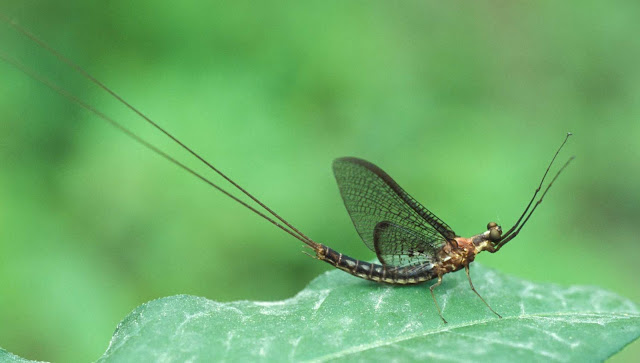I spent a recent afternoon with Dr. Deb Finn and a pack of aquatic entomology students hiking up a small intermittent stream to study the Glossosomatidae caddisfly larvae we wrote about recently. We were soon distracted by mayfly larvae, called nymphs or naiads, swarming in the riffles. Once collected in my bug box, one stood out from the rest with its thicker stripped cerci (tail).
 |
| Ameletus lineatus mayfly |
When I dig in the internet for the information on an insect, frequently the most complete resources are sites about killing them. In the case of the mayflies however, it was more about who tries to catch what eats them. Troutnut.com had some information on Ameletus sp., a genus known also as brown duns. As you might expect, this site focuses on the aquatic phase where they spend 99% of their life as nymphs. Adults of most mayfly species live only two hours to three days, some less than 90 minutes!
"Ameletus nymphs are very fast swimmers. They are occasionally mistaken (especially in early instars) for some species in the Baetidae family, having roughly similar body shape and coloration. They are easily separated under close inspection based on gill coloration and prominent mouth parts. As mature nymphs their large size and intense maculation (spotting) make them much easier to differentiate from others." Troutnut.com
 |
| Leptophlebia sp. mayfly |
These nymphs were speedy and required the fast hands of a student. They only caught one Ameletus sp specimen while all the rest of the mayfly nymphs flitting around in the flowing water were Leptophlebia sp. The latter were distinguished by their long thin tails (cerci) and feathery gills along the abdomen.
 |
| Mayfly naiad - MDC |
Mayfly nymphs are important lower rungs in the food chain of a healthy stream. Even in rapid water there is slower flow in the very bottom where detritus collects, particles of "dead stuff." This and diatoms or micro algae are grazed and digested into energy and growth by the six instars of nymphs as they crawl through the stream bottom on their way to a brief adult life. They will they emerge from the water as a subimago, able to fly but sexually immature until after another molt.
 |
| Mayfly molting - Wikimedia |
 |
| Mayfly adult - MDC |
========
More details on mayflies in general at this Wikipedia link.
Thanks to Cameron Cheri for wisdom and the Missouri State University stream ecologists for letting me tag along.
